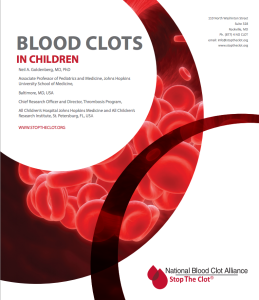What are the possible long-term effects of DVT/PE in children?
Potential long-term effects of DVT/PE depend on the parts of the body or organs involved. For example:
- After a child experiences a leg or arm DVT, the clotted vein can be damaged by the increased pressure so that they no longer work as well in bringing blood back toward the heart as they did before the DVT. This condition – known as “chronic venous insufficiency” or “post-thrombotic syndrome (PTS)” – develops in about 25% of patients after a DVT.
- Children with PTS can have swelling, color changes, a rash or sores on the skin of their arm or leg where they had the DVT.
- Children with PTS can also have pain, aching, heaviness, itching or tingling in the arm or leg where they had the DVT.
- For most children who develop PTS, the symptoms are mild, and mainly occur after standing or exercising for a long time.
- PTS symptoms are usually improved by elevating the affected arm or leg and using custom-fit graduated compression stockings (GCS) that are prescribed by your child’s doctor.
- After a PE, children can sometimes develop long-term breathing problems from pulmonary hypertension. This condition results from increased pressure in the pulmonary artery, which brings blood from the heart to the lungs. Other times, long-term breathing problems can occur from areas of lung damage (known as pulmonary infarction) due to blockage in blood flow.
- If a CSVT (cerebral sinovenous thrombosis, a DVT of the veins that drain blood flow from the brain) has caused bleeding or infarction (damage to the brain tissue) due to increased pressure in the vessels of the brain, then a child can have long-term neurological difficulties, such as weakness of one side of the body or face. Children can also develop chronic headaches if there is increased pressure in the brain from chronic blockage in the drainage of blood back to the heart. If the increased pressure affects the optic nerve at the back of the eye, it can cause blurred vision and long-term vision damage. Procedures can be done to prevent vision damage when this situation occurs.
- Children with DVT of the kidney veins (known as renal vein thrombosis) can develop high blood pressure.
- Children with DVT of the liver veins (known as hepatic vein thrombosis) or the portal vein (portal vein thrombosis) can result in spleen enlargement, which can cause low blood cell counts. Hepatic and portal vein thrombosis can cause bleeding in the stomach or esophagus from increased pressure in the veins that return blood to the heart from these areas. (Note: The portal vein drains blood from the intestines, spleen and other organs into the liver).
Neil A. Goldenberg, MD, PhD
Professor of Pediatrics and Medicine, Johns Hopkins University School of Medicine,
Baltimore, MD, USA
Founding Director, Pediatric Thrombosis & Stroke Programs
Johns Hopkins All Children’s Hospital
St. Petersburg, FL, USA
Updated: September 2024





